Event recap: Youth Day and the 2017 Tribal Summit
/1 Comment/in Events, News, Project update /by Kelsey FitzgeraldUpcoming Event: Youth Day at the Desert Research Institute
/16 Comments/in Events /by Kelsey FitzgeraldNative Waters on Arid Lands is pleased to announce that this year’s Tribal Summit will include Youth Day, a day in which tribal youth are invited to the Desert Research Institute in Reno, Nev. to participate in hands-on science activities with DRI researchers and learn about careers in the sciences. Youth Day will take place on November 13, 2017, from 10am to 2:30pm.
Youth Day Agenda
- Session 1: Truckee Meadows land, water and people – A hike with DRI experts to learn about how land, water and people have shaped the Truckee Meadows (with Amanda Keen-Zebert and Teresa Wriston)
- Session 2: Climate – “The Real Deal” – Interactive session of climate Q&A debunking myths and legends about climate change, and decoding climate information (with Christine Albano, Dan McEvoy and Tamara Wall)
- Lunch (provided) – STEM pipeline discussion. Roundtable discussion of opportunities after high school (with Steven Chischilly, Virgil DuPuis, Helen Fillmore)
- Session 3: Playing with your food – Experiences from the Pueblo Farming Project and extracting DNA from a banana (with Kyle Bocinsky, Zoe Harrold and Lucas Bishop)
- Session 4: Force of Water – Hands-on activities related to flooding and adaptation from the Force of Water Green Box (with Science Alive staff Mackenzie Peterson and Leah Madison)
Youth Day will be held at the Desert Research Institute, 2215 Raggio Parkway, Reno. For more information about this event, please contact Meghan Collins at meghan.collins@dri.edu.
Arizona Climate Resilience Workshops: Sept 12 & 14, 2017
/in Events /by Kelsey FitzgeraldNative Waters on Arid Lands will hold climate resilience workshops on September 12, 2017 at Dine College (Tsaile, AZ) and on September 14, 2017 at the Colorado River Indian Tribes reservation (Parker, AZ). The purpose of these workshops is to make climate data available and accessible to tribal partners to inform discussions about the impacts to traditional and production livestock and crop agriculture from warming temperatures and extreme precipitation events and options to enhance the climate resiliency of tribal agriculture.
The workshop agenda is as follows (Download PDF):


Registration open for Native Waters on Arid Lands 2017 Tribal Summit
/1 Comment/in Events /by Kelsey FitzgeraldNWAL holds first climate resilience workshop
/19 Comments/in Events, News /by Kelsey FitzgeraldThe end of a multi-year drought has created new challenges for farmers on tribal lands in Nevada, according to participants in a Climate Resilience Workshop held by Native Waters on Arid Lands (NWAL) on May 9, 2017. After above-average winter precipitation during the 2017 water year, drought conditions have given way to an excess of water in parts of the state, causing problems such as flooded fields, delayed planting schedules, and invasive weed growth.
The workshop, which was held in conjunction with Nevada FRTEP‘s Nevada Indian Summit, provided an opportunity for NWAL researchers and tribal members to share information about the impacts of the recent drought and the current winter’s water supply on traditional and production agriculture in Nevada. A full agenda for the workshop and Summit is here.
More than 35 people attended the one-day workshop, including members of the Duck Valley Shoshone-Paiute Tribe, Walker River Paiute Tribe, Pyramid Lake Paiute Tribe, Yerington Paiute Tribe, Fort McDermitt Paiute and Shoshone Tribe, Duckwater Shoshone Tribe, the Elko band and South Fork band of the Te-Moak Tribe of Western Shoshone, Cheyenne River Sioux, the University of Nevada Cooperative Extension, University of Nevada, Reno, Utah State University, University of Arizona, the Desert Research Institute, Western Regional Climate Center, Great Basin Landscape Conservation Cooperative, USGS and the USDA.
This workshop for members of Nevada tribes was the first of three climate resilience workshops that will be held by Native Waters on Arid Lands. In future months, there will also be workshops for Arizona/New Mexico tribes and Utah tribes.
RECAP OF TALKS AND DISCUSSIONS
Reflecting on precipitation patterns
Nina Oakley, Regional Climatologist with the Western Regional Climate Center at the Desert Research Institute, provided an overview of recent drought and precipitation patterns in Nevada.
Nevada experienced the wettest Dec-Feb conditions in a 123-year period of record during 2017, Oakley said, as atmospheric river storms dropped moisture throughout the region. At present, according to the US Drought Monitor, the state is drought-free, with only a few areas that are “abnormally dry”.
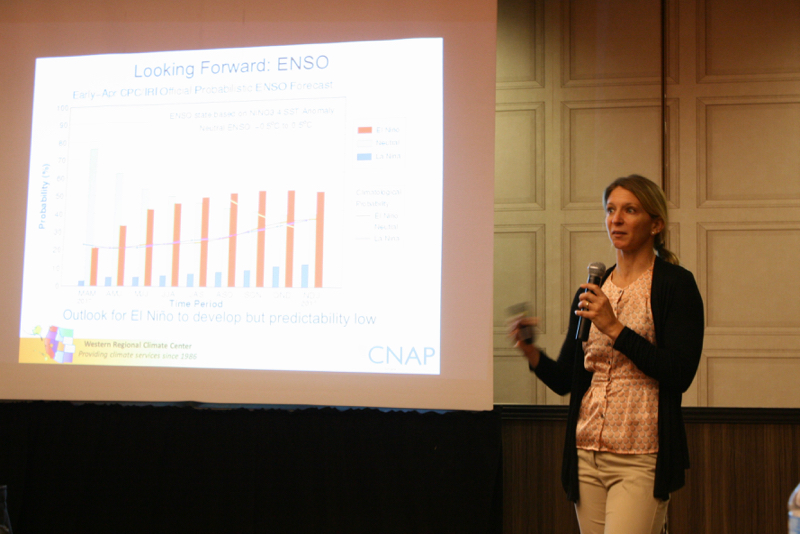
Nina Oakley, Regional Climatologist with the Western Regional Climate Center, speaks at NWAL’s Climate Resilience Workshop on May 9, 2017.
During the last two decades, Oakley explained, we’ve experienced three notable periods of drought, each followed by a wet year: a drought from 2001-2005, a wet year in 2006; a drought from 2007-2010, a wet year in 2011; a drought from 2012-2016, and a wet year in 2017. Although conditions across Nevada are currently quite wet (the April 1 snowpack was 110 to 220 percent of normal across the state), it seems likely that drought conditions will return again in future years. Oakley also noted that summer 2017 is expected to be warmer than average in Nevada.
Roundtable discussion: Impacts of recent drought and wet years
A roundtable discussion led by NWAL team members Staci Emm (University of Nevada Cooperative Extension) and Kynda Curtis (Utah State University) asked workshop participants to reflect on the impacts of recent years (2012 to 2017) on tribal water supplies and traditional and production agriculture.
During drought years, impacts to farmers included:
- Reductions in crop production/crop yields and loss of income.
- Loss of entire fields of alfala, which now must be replanted (alfalfa can generally be harvested for five years without replanting, and can be cut several times during the growing season).
- Less water available for irrigating, which resulted in fewer cuttings of alfalfa than normal.
As conditions across much of Nevada have changed from very dry to very wet, impacts reported by workshop participants included:
- An increase in noxious weeds in their fields, including species they haven’t seen before which were brought in by flooding.
- Swampy conditions in growing fields, or fields that are completely underwater. This delays/prevents planting, and may create problems with mosquitos.
Other impacts experienced by workshop participants included:
- An increase in the length of the growing season (with more warm days earlier in the spring and later in the fall), which requires more irrigation water to support crops.
- Day-to-day temperature variations.
- Weeds such as Canada thistle, Musk thistle and Scotch thistle can ruin an entire field of alfalfa; these pop up after the field is plowed for planting.
To adapt to the climate conditions experienced during recent years, some farmers have made changes to agricultural practices, including:
- Planting triticale (a wheat/rye hybrid that is drought-tolerant, high in protein, and must be replanted annually). Workshop participants reported planting this crop instead of alfalfa, or planting it in the same field as alfalfa. They reported that it grows so thick that it crowds out weeds. It can be planted in fall and harvested in spring, requiring no irrigation.
- Planting experimental crops, like teff. Teff is a fast-growing annual and good for animal feed, but doesn’t do well in the cold. It is an Ethiopian grain that is high in iron and protein. Teff can also be eaten by people.
- Adjusting the timing of planting. If fields are too wet, crop planting occurs later in the season.
- For community gardens and small-scale family gardens, hoop house projects have become popular.
Conference participants were asked to reflect on which changes worried them the most, economically and culturally. Concerns included:
- The potential for increased numbers of crickets and grasshoppers, which feed on alfalfa and other crops. This has happened in the past after similar cycles of drought and wetness.
- Difficulties related to planning and figuring out what to spend money on during times of uncertain climate conditions.
- Concerns about planting alfalfa (a five-year crop) given the recurring cycle of drought periods that has occurred during recent years.
- Concerns regarding the behavior of honeybees. Bees form a tight ball in the hive to stay warm during winter, and “unball” when the weather warms. As we experience more warm days early in the spring, bees may unball too early and be killed by a late freeze. Colony Collapse Disorder is also a concern.
- The cost and risk involved with growing experimental crops. The cost of buying equipment for planting new crops can be prohibitive.
Opportunities for future adaptation:
- Buy a cuber. Weeds like Canada thistle, Scotch thistle and Musk thistle can ruin an entire crop of alfalfa; sometimes the field must be burned to kill the seeds. Equipment called a “cuber” could be purchased, which turns hay or alfalfa into small cubes (pellets) and cooks the seeds in the hay so that they are no longer viable. This equipment would be expensive, but maybe a good investment for a group of farmers to share.
- Grow native plants for seed. In Nevada, seeds of native plants are needed/required by some federal agencies for post-fire rehabilitation in burned areas. Penstemon, basin wildrye, and indian ricegrass were a few options mentioned; farmers should check and make sure there’s a good market for whatever they decide to grow. Comstock Seed is one organization that buys seed.
- Develop a cooperative marketing strategy. Small farmers from tribal lands must compete in the market against large producers. Can we create a marketing strategy that groups together people from various reservations to collectively market goods?
- Apply for funding from government programs.
- Value Added Producer Grants are available from the USDA. These cannot be used to purchase equipment, but could be used for a feasibility study.
- Socially-Disadvantaged Groups Grants from the USDA provide assistance in development of cooperatives.
Past and future climates of the Southwestern US
After the roundtable discussion, Dr. Michael Dettinger, a Senior Hydrologist with the USGS and member of the NWAL team, gave a presentation about past climates of the southwest and predictions for future change. In his talk, Dr. Dettinger provided an overview of what scientists have learned about changes in climate in the Northern Hemisphere and Great Basin over many thousands of years, including evidence of temperature changes and ancient megadroughts, with information obtained from sources like tree rings, flood sediments, sediments/microfossils, geochemistry and ice cores.
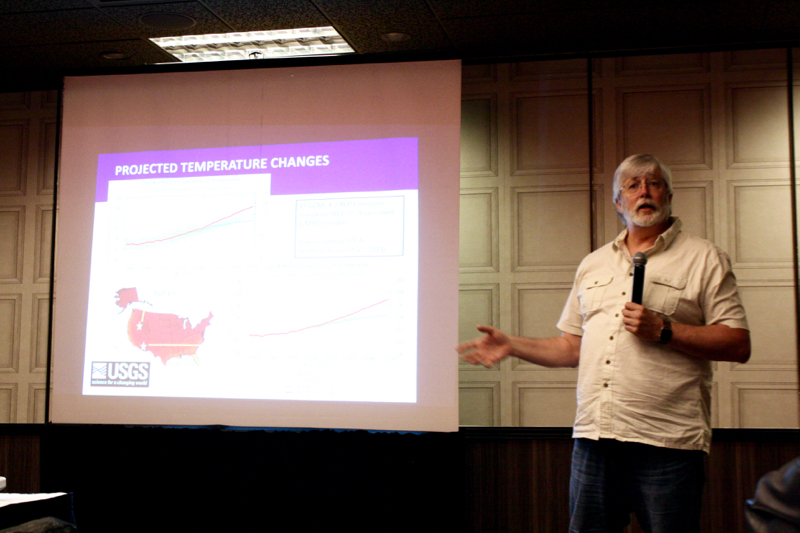
Dr. Michael Dettinger discusses past climates of the southwest and predictions for future change at NWAL’s Climate Resilience Workshop on May 9, 2017.
In recent times, CO2 levels in the earth’s atmosphere have spiked dramatically. Temperature projections show that increases of 3-9oF degrees are likely by the end of the century, Dettinger said, and scientists are already observing changes such as an increase in the amount of precipitation falling as rain (versus snow), warming temperatures, earlier snowfed streamflow, and lower snowpacks across the west. In the NWAL study area, he has created climate projections for individual reservations that show changes in temperature and precipitation through the end of the century. According to the projections, we should expect warming across the region and an increase in the range of variability of precipitation (the large storms will get larger, and the number of dry days will increase as well).
Roundtable discussion: Making climate data accessible
NWAL team members Dr. Alex Lutz and Christine Albano led a discussion between researchers and tribal members to gather feedback about how to best make climate data accessible and useful for climate adaptation planning, water management and agricultural decision-making.
Suggestions from workshop participants about data delivery needs included:
- NWAL should provide climate predictions that go six months out, to help farmers figure out when to plant or harvest crops.
- Provide weather data that goes six months back. This is what farmers need to give farm service agencies.
- Send information by email, in quarterly updates that are short and to-the-point.
Overall, farmers expressed interest in data related to:
- For farmers of alfalfa, warmer weather results in faster growth, and there seems to be no upper temperature limit. Cooler weather results in slower growth.
- Mid-summer precipitation. Rain that falls on a crop after it is cut is very bad, but between cuttings, rain is good for the crop.
- Changes in snow versus rain.
- Changes in the timing of snowmelt runoff. In some regions, farmers have no water storage, and rely entirely on runoff for farming.
Several farmers also provided information to the research team about some of the challenges and logistics involved in growing the following crops:
- Alfalfa: High temperatures are not a concern for alfalfa farmers, because warm temperatures result in faster growth. In southern Nevada, they get ten cuttings per year in 120oF temperatures. As long as there is enough water, it grows well. When weather is cooler, alfalfa growth slows down, and frost shuts down growth. If you’re harvesting alfalfa for cattle and horses, you want about 10-15% of the field to bloom. For dairy quality hay, you have to cut it before it blooms.
- Teff: An annual. Does not do well in the cold.
- Triticale: An annual. Does well when planted in the fall because it likes cooler weather and winter moisture. Farmers who plant this crop early in fall can let cattle graze on it and then later let it go for hay. Alfalfa and triticale can be planted in the same field, because they are harvested at different times.
- Birdsfood trefoil: A perennial. Makes good feed for cattle, needs very little water. Grows up by Susanville in the wild, and in Gardnerville in pastures. A legume.

Participants at the NWAL climate resilience workshop discuss challenges and adaptation strategies related to farming. May 9, 2017.
Roundtable discussion: Adaptations in agriculture
In the final roundtable discussion, NWAL team members Dr. Beverly Ramsey (Director, Earth & Ecosystems Science, DRI) and Trent Teegerstrom (Native Programs Director, University of Arizona) asked workshop participants to share thoughts about how to adapt agriculture to increasing variability of water supplies and warming temperatures. Much of the discussion focused on the use of hoop houses.
Hoop house projects have become popular on many reservations.
- In AZ, people are using hoop houses to grow fruit trees at higher elevations.
- In NM, people use hoop houses to start plants, so that they can get them into the ground at the right time to align with water resources
- Hoop houses must be built with the right materials, built for UV resistance. Plastic breaks down over time; maintenance is needed.
- Hoop houses are useful in growing nutritious, locally produced food. Can be used to grow food year-round, depending on the crops. A great asset for reservations that are located a long distance from a grocery store.
- Small-scale family owned hoop houses are working well.
- For community gardens or larger community hoop houses, it may be best to hire an employee to be in charge of daily operations. Otherwise, there have been problems with maintenance (for example, having someone responsible for opening the vents every day).
- At lower elevations, or as temperatures warm, you can remove the plastic from the top of hoop houses and put up shade cloth.
Certifications
- Good Agricultural Practices (GAP) certification is one way that farmers can protect themselves, if concerned about food safety standards.
Second Annual Native American Nutrition Conference
In closing, Beverly Ramsey encouraged workshop participants to consider attending the second annual Native American Nutrition Conference, which will be held Sept 19-20, 2017 in Prior Lake, MN. This conference is organized by Seeds of Native Health, with talks and workshops focused on native nutrition and food sciences. Beverly attended the first conference, and found it to be a very worthwhile event. Seeds of Native Health also offers scholarships to tribal members and officers. For more information, visit: http://seedsofnativehealth.org/conference/
For more information on this workshop or the Native Waters on Arid Lands program, please contact Dr. Maureen McCarthy at maureen.mccarthy@dri.edu.
Climate Resilience Workshop: Sparks, NV – May 9, 2017
/in Events /by Kelsey FitzgeraldNative Waters on Arid Lands will hold a climate resilience workshop on May 9, 2017 in Reno, Nevada, as part of the Nevada Indian Summit (held May 10-11, 2017). The purpose of this workshop is to make climate data accessible and useable to Nevada tribal ranchers, farmers, and resource managers for water management and traditional and production agricultural development and sustainability.
The workshop agenda is as follows (Download PDF):
A Successful 2016 Summit
/17 Comments/in Events, News /by Kelsey FitzgeraldOn November 9-10, 2016, more than 100 people gathered at the South Point Hotel Casino in Las Vegas for the second annual Native Waters on Arid Lands (NWAL) Tribal Summit. Conference speakers and other attendees came from communities and reservations located across Arizona, Nevada, Colorado, California, New Mexico, Utah, South Dakota, Montana, Wisconsin, Georgia, and Ohio to share in two days of workshops and talks related to water resources and climate change on tribal lands.
Wednesday, Nov. 9
On Wednesday, a pre-conference breakout session introduced Summit attendees to a series of climate change projections for nine reservations in the Southwestern US, and presented an overview of the climate adaptation programs, trainings, resources and funding opportunities that tribes may access through the Bureau of Indian Affairs (BIA) and Institute for Tribal Environmental Professionals (ITEP).
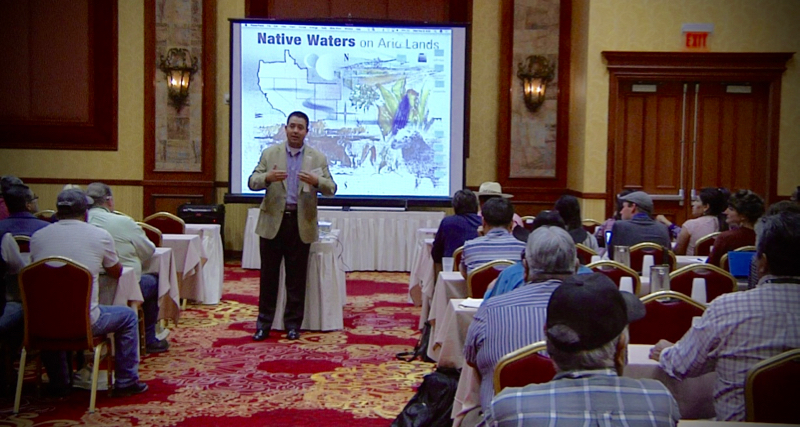
Joe Jojola from the Bureau of Indian Affairs speaks at the NWAL Summit’s preconference breakout session. Nov 9, 2016.
The conference formally opened with a blessing from Clayton Honyumptewa of the Hopi Tribe, and an overview of tribal water rights by Heather Whiteman Runs Him. Whiteman Runs Him is a staff attorney for the Native American Rights Fund in Boulder, CO, and discussed several foundational cases in tribal water rights, approaches for quantifying rights, emerging issues, and case studies from different reservations.
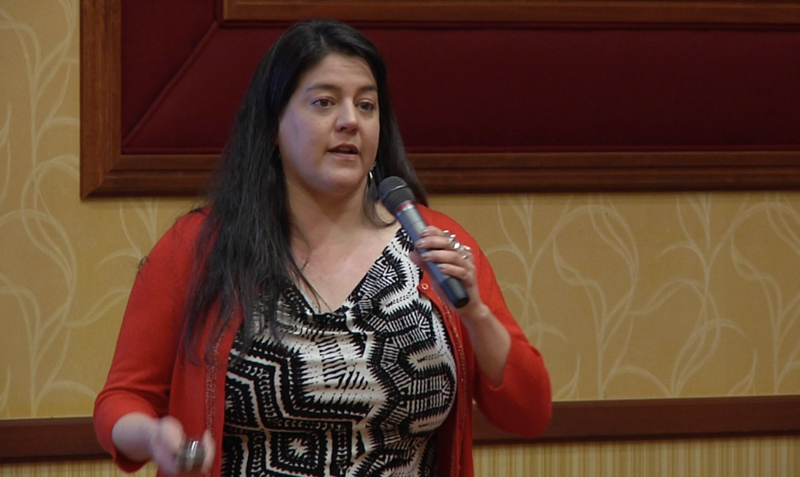
Heather Whiteman Runs Him speaks about Tribal Water Rights at the 2016 NWAL Summit. Nov 9, 2016.
During the two-day conference, a series of breakout sessions covered a variety of topics related to the use of tribal water resources in a changing climate. Speakers included representatives from the Agua Caliente Band of Cahulla Indians, Ute Indian Tribe, Gila River Indian Community, Yerington Paiute Tribe, Pyramid Lake Paiute Tribe, Duck Valley Shoshone-Paiute Tribe, Jicarilla Apache Tribe, Colorado River Indian Tribes, Hopi Tribe, White Mountain Apache Nation, Pueblo of Zuni, Navajo Nation, and the Salt River Maricopa Indian Community (the full program for the 2016 Tribal Summit is available here).
The first breakout session, titled “Groundwater and Surface Water Relationships Affecting Reservation Environments,” explored challenges related to water rights and water quality on tribal reservations. Some presenters discussed ongoing legal disputes related to groundwater and surface water rights, and methods for quantifying those rights. For others, problems related to pollution and chemical contamination of water sources were of more immediate concern.
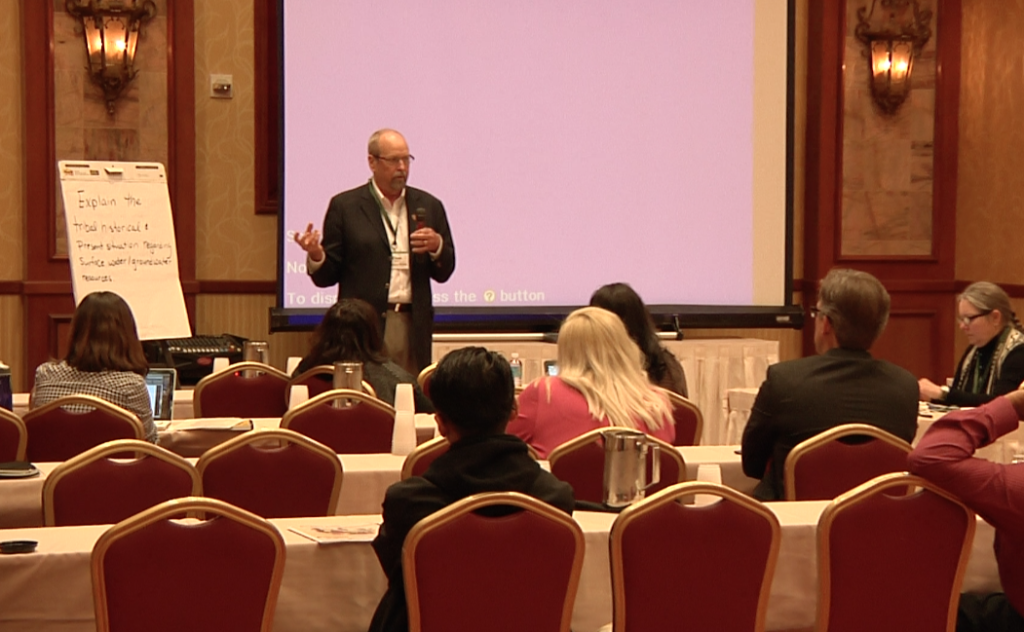
Tom Davis, Chief Planning & Development Officer for the Agua Caliente Band of Cahulla Indians (Palm Springs, California) speaks during the first breakout session. Nov 9, 2016.
The second breakout session, “Invigorating Tribal Economies through Innovative Water Resource Use,” focused on new ideas and opportunities for using tribal water resources in economically beneficial ways. Examples discussed by the session speakers included fisheries projects, water leases, and improved water conveyance/delivery structures for agriculture. One key theme that emerged from this session was that is important for tribes to secure and quantify their water rights in order to effectively manage water resources to invigorate tribal economies.
Thursday, Nov. 10
The second day of the Tribal Summit began with a presentation about Tribal Colleges and Universities (TCU) programs, and an overview of the internships and opportunities that are available to students who are interested in hydrology, water resources, range management and other disciplines.
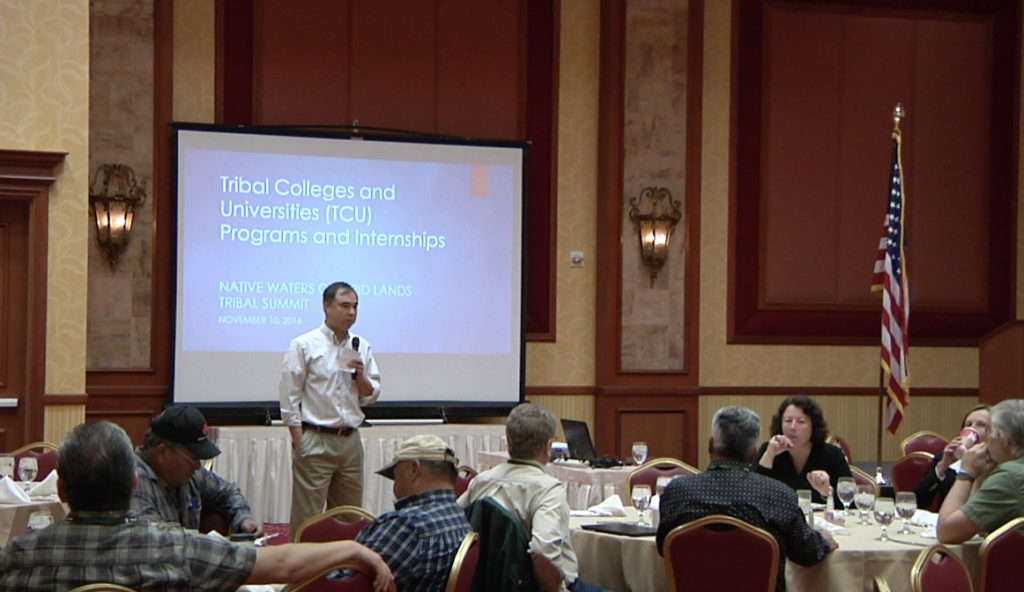
John Phillips (FALCON) presents information on Tribal Colleges and Universities programs and internships. Nov 10, 2016.
A breakout session titled “Tribal Rangeland and Livestock Conservation Practices,” introduced attendees to challenges faced by ranchers on tribal lands, such as land tenure issues, rangeland habitat degradation, and funding cuts. To deal with these challenges, presenters discussed solutions such as habitat conservation measures, water pipelines, livestock associations, livestock inventories, impoundments for capturing feral and escaped animals, range management plans, a traditional fisheries recovery project, and more.
A breakout session titled “Traditional Knowledge and Ecology” explored best practices in Native American agriculture for climate resiliency that incorporates traditional knowledge. Speakers from the Hopi Corn Project, the Black Mesa Water Coalition, the Zuni Project and the Salt River Pima Maricopa Indian Community Garden discussed projects that utilize and adapt traditional knowledge for modern-day agricultural practices.

During a session titled “Traditional Knowledge and Ecology”, presenters discussed projects that combine modern and traditional knowledge in agricultural practices. Nov 10, 2016.
In a lunchtime talk, Chairman Harold Frazier of the Cheyenne River Sioux spoke about opposition to the Dakota Access Pipeline at the Standing Rock Reservation in North Dakota, and the potential impacts to sacred grounds and water resources.
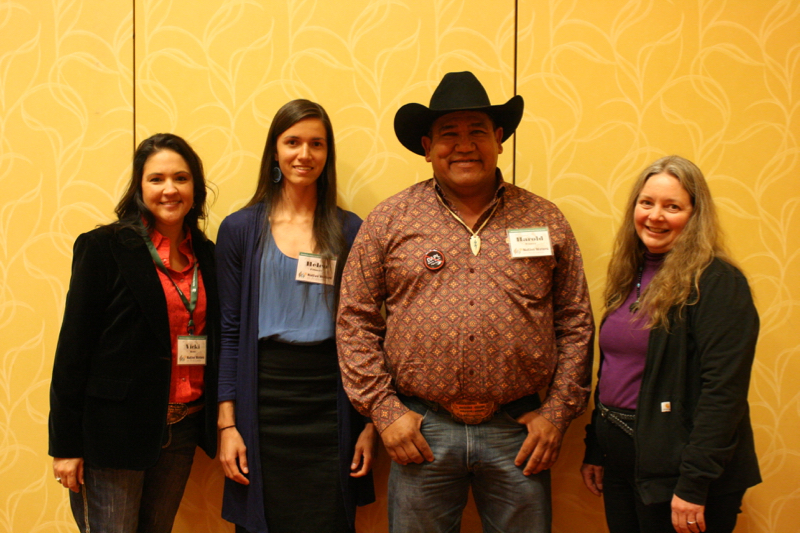
Left to right: Vicki Hebb, Helen Filmore, Chairman Harold Frazier (Cheyenne River Sioux) and Maureen McCarthy at the 2016 Tribal Summit. Nov 10, 2016.
A final synthesis session led by Native Waters team member Derek Kauneckis of Ohio University asked participants to share insights regarding key takeaways from the Tribal Summit. The Summit closed with a blessing from Robinson Honani of the Hopi Tribe.
An in-depth report on the proceedings and outcomes of the 2016 Tribal Summit is available here. The Native Waters team would like to thank everyone who was able to join us in Las Vegas. We hope to see you again next year!
Thank you!
/in Events /by cclackThank you to those that attended the recent Tribal Summit at the South Point Hotel in Las Vegas, Nevada. Click here for the Agenda.
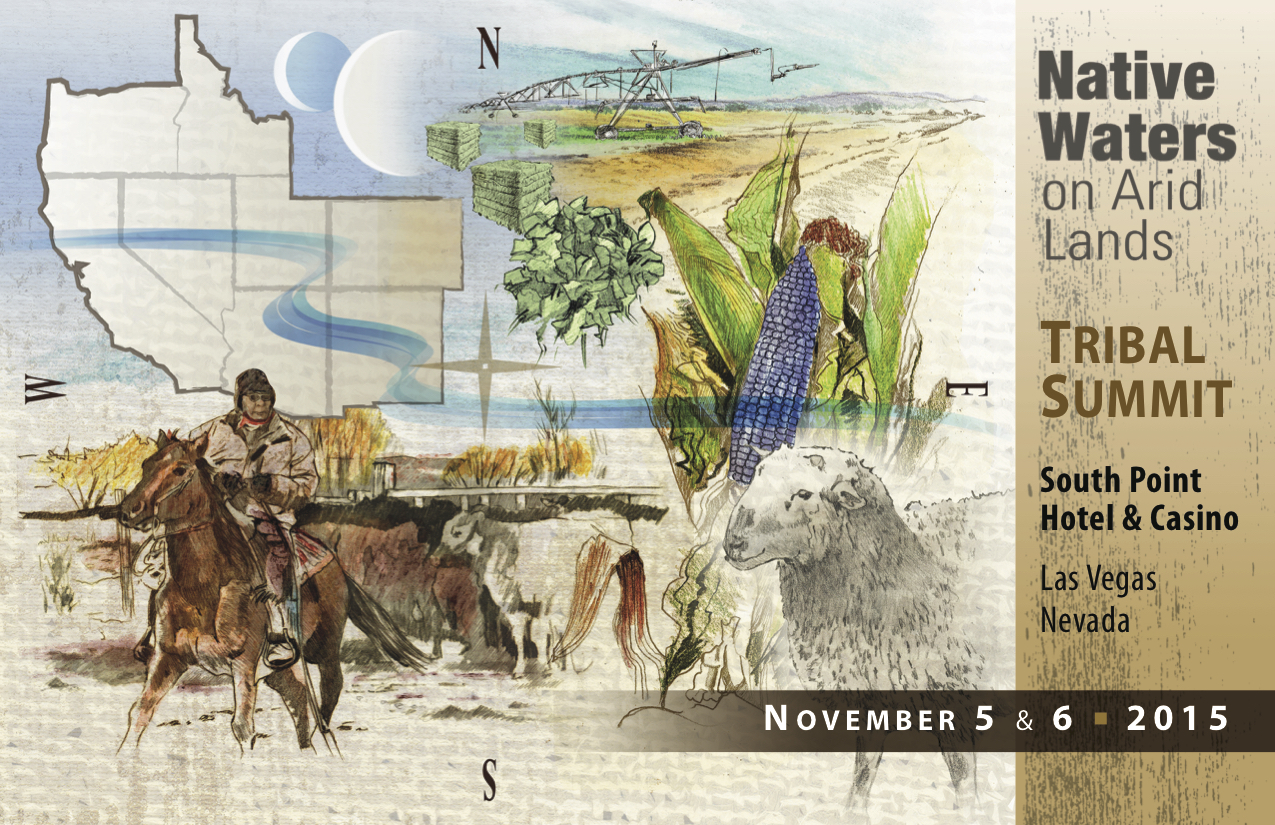
Save the Date
/in Events /by cclackFIRST ANNUAL
TRIBAL SUMMIT
November 5-6, 2015
South Point Hotel & Casino
Las Vegas, Nevada
Native Waters on Arid Lands project seeks to build capacity among tribal communities in the Great Basin and American Southwest to enhance climate resiliency of water resources and agriculture. For more information on the Tribal Summit, view the Tribal Summit Program and Agenda (PDF).
SUMMIT CONTACTS
Vicki Hebb, Summit Organizer University of Nevada Cooperative Extension
(605) 222-2062
Staci Emm, Extension Educator University of Nevada Cooperative Extension
(775) 945-3444 (Ext. 10)
About
The Native Waters on Arid Lands project seeks to enhance the climate resiliency of agriculture on American Indian lands of the Great Basin and Southwest by building the capacity within tribal communities to develop and implement reservation-wide plans, policies, and practices to support sustainable agriculture and water management.
Business Hours
Our support Hotline is available 24 Hours a day: (555) 343 456 7891
- Monday-Friday: 9am to 5pm
- Saturday: 10am to 2pm
- Sunday: Closed
Latest News
 Rainwater Harvesting on the Hualapai Reservation: New Research by Brianda Hernandez RosalesAugust 1, 2022 - 10:41 pm
Rainwater Harvesting on the Hualapai Reservation: New Research by Brianda Hernandez RosalesAugust 1, 2022 - 10:41 pm Maureen McCarthy/DRINew USDA Grant to Support Climate Resilience Planning in Indian CountryJanuary 13, 2022 - 5:59 pm
Maureen McCarthy/DRINew USDA Grant to Support Climate Resilience Planning in Indian CountryJanuary 13, 2022 - 5:59 pm- Presentations from FALCON Conference now availableDecember 14, 2021 - 8:13 pm

